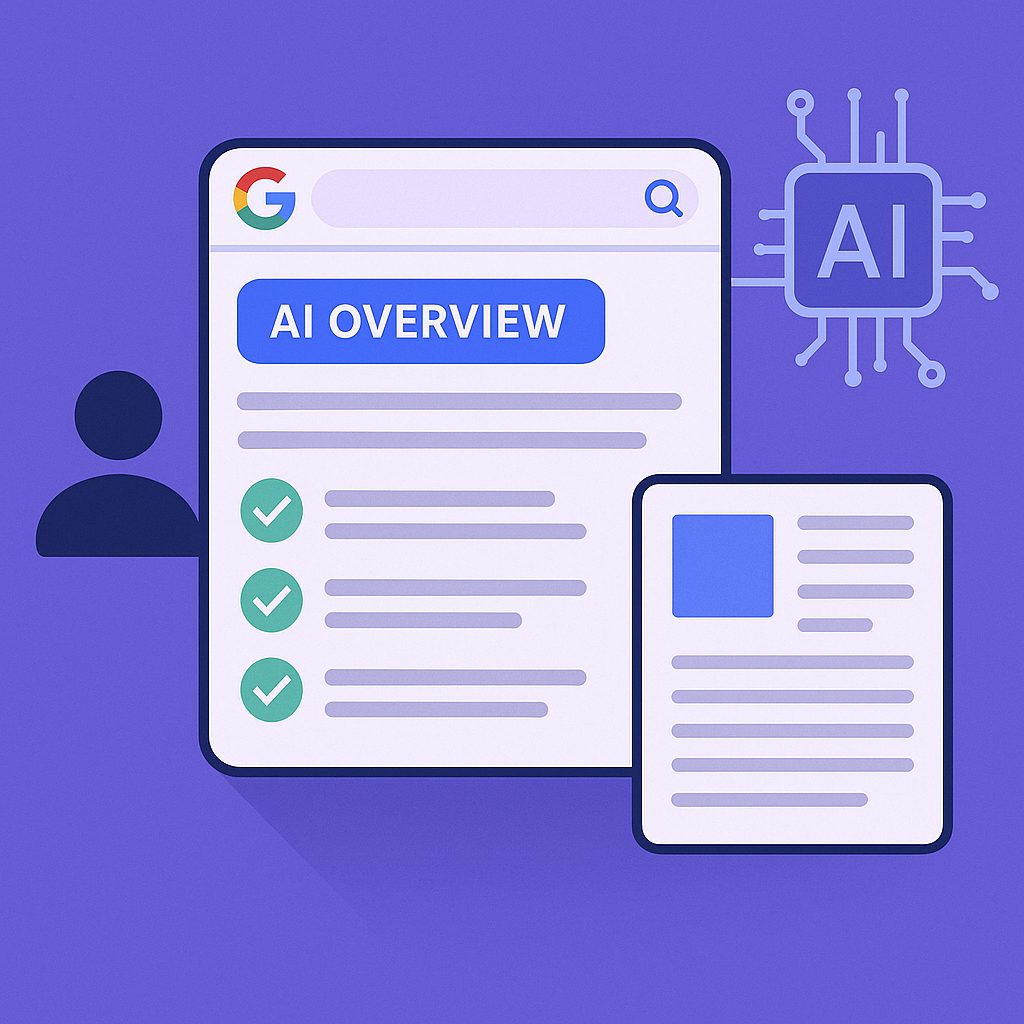What Are AI Overviews? An Eazy-Peazy Guide!
Once upon a time, searching on Google was straightforward. You’d type in a query and scroll through a neat stack of blue links. And SEO was all about getting to the top of that stack.
But all that is rapidly changing.
Now, with Google’s AI Overviews, users get quick, AI-generated answers right at the top of the page, before they even see a single link.
This is transforming how people interact with search and redefining what it means to rank.
So, what exactly are AI Overviews?
How are they impacting your visibility in search results?
And most importantly, how can you adapt?
Let’s get into it.
What Are Google AI Overviews?
AI Overviews is a feature in Google Search that uses generative AI to provide quick, summarized answers to users’ queries.
Instead of serving the usual list of blue links, it delivers an instant answer, generated from multiple sources, right at the top of the results page.
Take this query, for instance:
“Can I use olive oil instead of butter in chocolate chip cookies?”
In the past, you’d scroll through a featured snippet, a few ads, and a stack of organic links just to find the best answer. Now, AI Overviews presents a boxed summary outlining key insights like:
-
How olive oil might affect flavor
-
The substitution ratio you should use
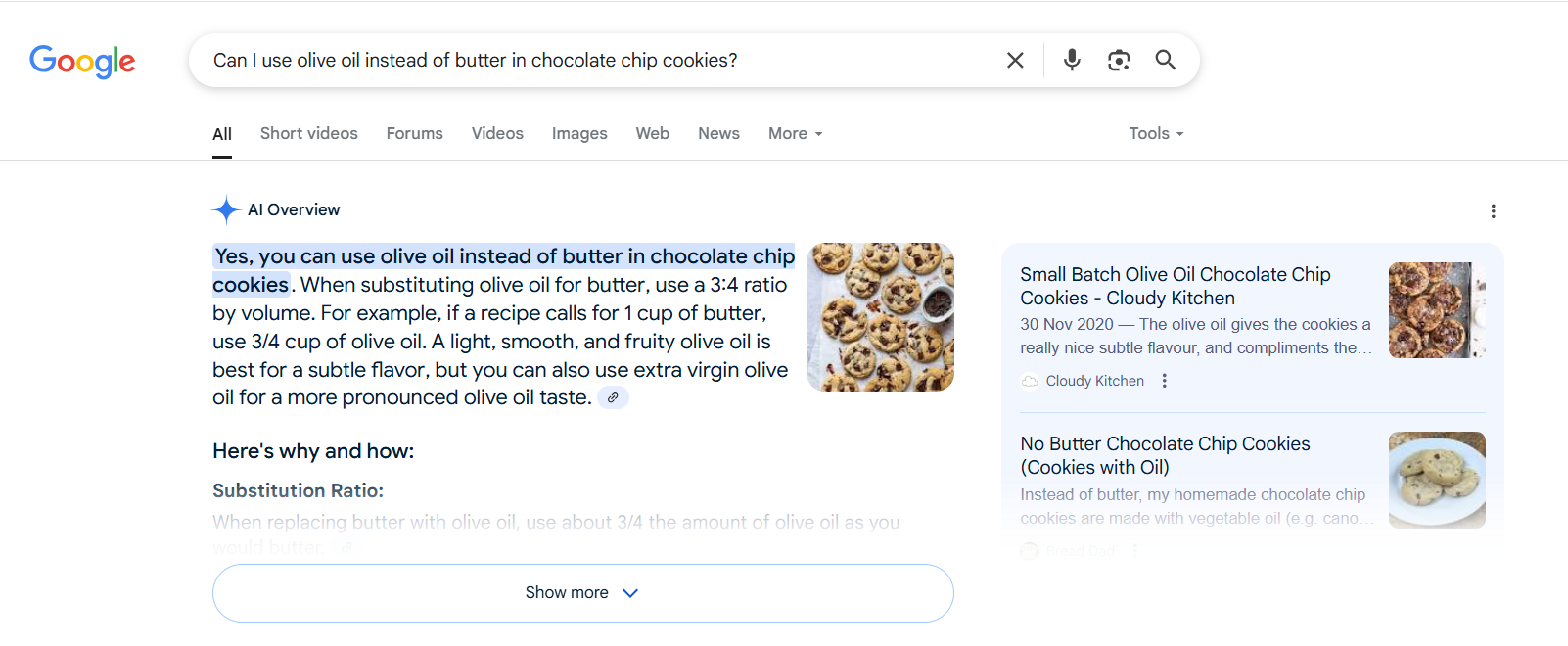
Beside the summary, you’ll find links to source pages for deeper reading or verification.
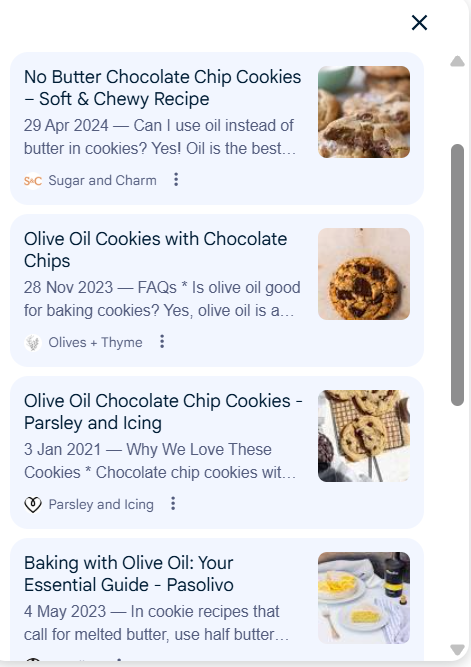
And just like that, you get an answer that feels human, accurate, and instantly useful, without ever clicking through.
A Brief History: The Origin of AI Overviews
AI Overviews didn’t appear overnight.
They’re the product of years of search innovation at Google.
It started with smarter algorithms like BERT (2019) and MUM (2021), which helped Google understand natural language and search intent on a deeper level.
Then came SGE (Search Generative Experience) in May 2023, an experimental rollout where users could test AI-generated summaries directly in search.
SGE used Google’s powerful Gemini language model (previously Bard/PaLM) to pull insights from across the web and deliver quick, conversational answers.
In May 2024, SGE was rebranded as AI Overviews and officially launched for all U.S. users, soon expanding to over 100 countries.
Now, these AI-powered summaries sit at the top of many SERPs, providing fast answers backed by source links.
And they’re showing up more frequently. In fact, as of March 2025, AI Overviews appeared in 13.4% of all Google searches, more than double the 6.49% we saw in January.
How Do AI Overviews Work?
It starts with Gemini, Google’s advanced generative AI model, which functions essentially like a supercharged research assistant.
Instead of reading one page at a time, Gemini scans dozens of high-quality sources, like articles, images, videos, PDFs, and distills the key insights into a concise, conversational summary.
Here’s what happens behind the scenes:
-
You search for something complex, like “Is vitamin C good for skin, and how should I use it?”
-
Google recognizes that the query needs a multi-part answer, so instead of just displaying links, it triggers an AI Overview.
-
The AI scans top-ranking pages, pulling insights from trusted, high-quality sources that address different parts of your question.
-
It then compiles a conversational response, often broken into clear steps or sections.
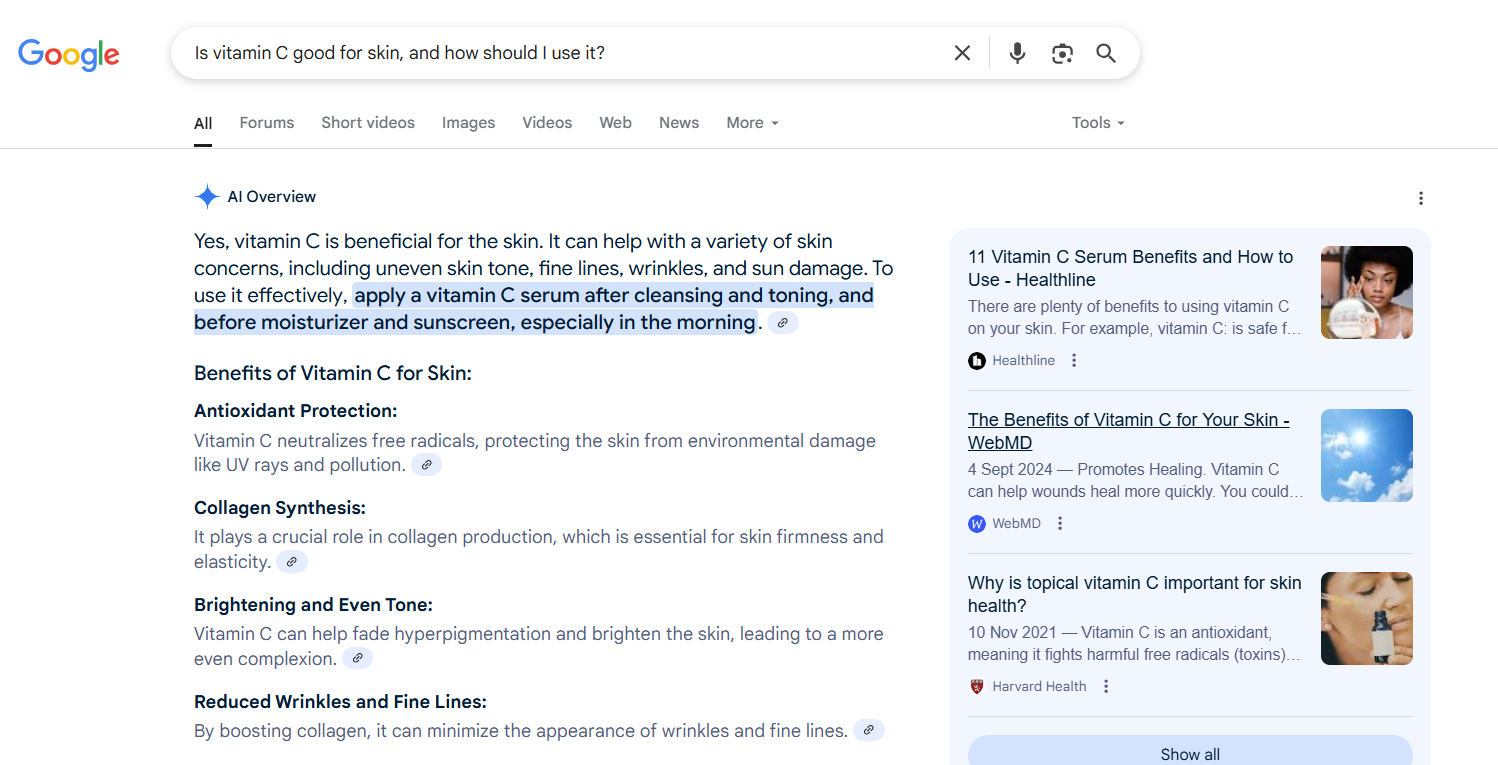
-
Source links appear beneath and beside the summary, so you can click through for deeper reading or verification.
The experience is smooth and encourages further reading, without necessarily driving traffic to third-party sites, something that has raised eyebrows in the SEO world (we’ll get to that soon).
How Do Google AI Overviews Look?
Google’s AI Overviews usually appear above the organic search results, ads, and sometimes even before featured snippets.
They’re placed in what SEOs call “position zero,” the very top of the Search Engine Results Page (SERP).
On desktop, AI Overviews dominate the screen space, often stretching across the top half of the page.
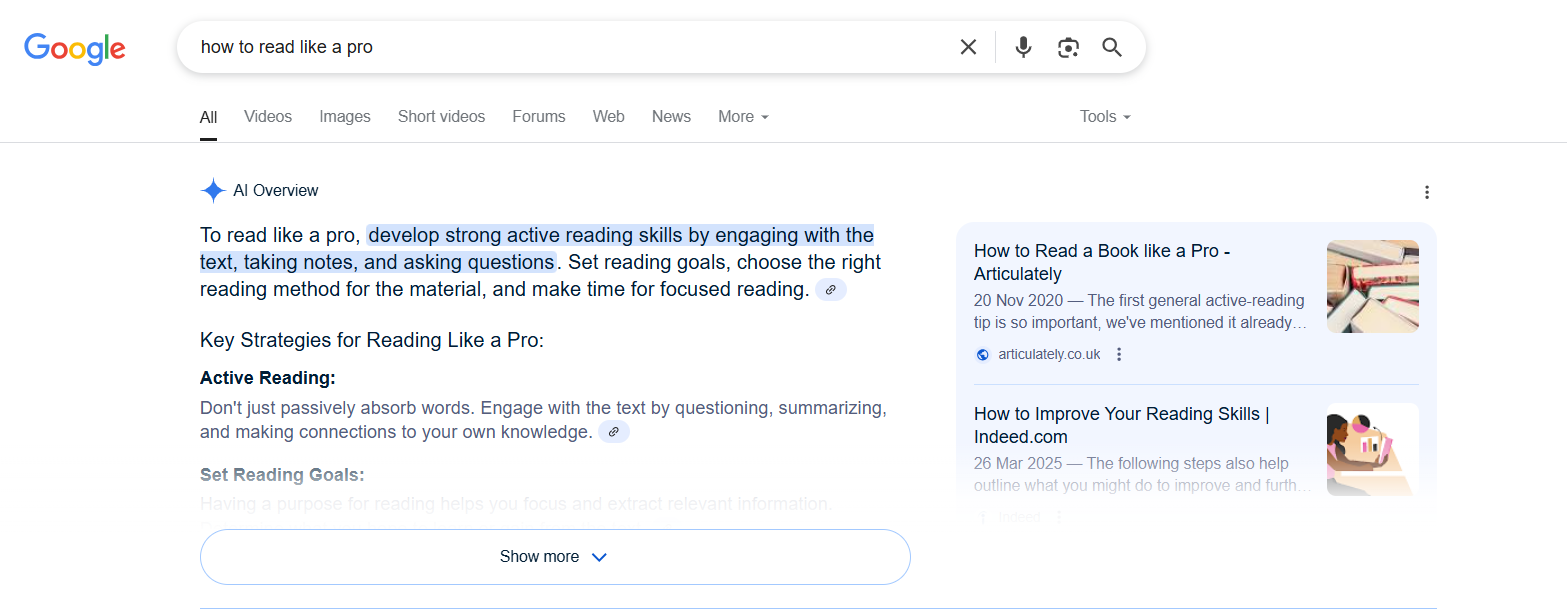
On mobile, they appear in card-like boxes and often take up the full initial viewport.
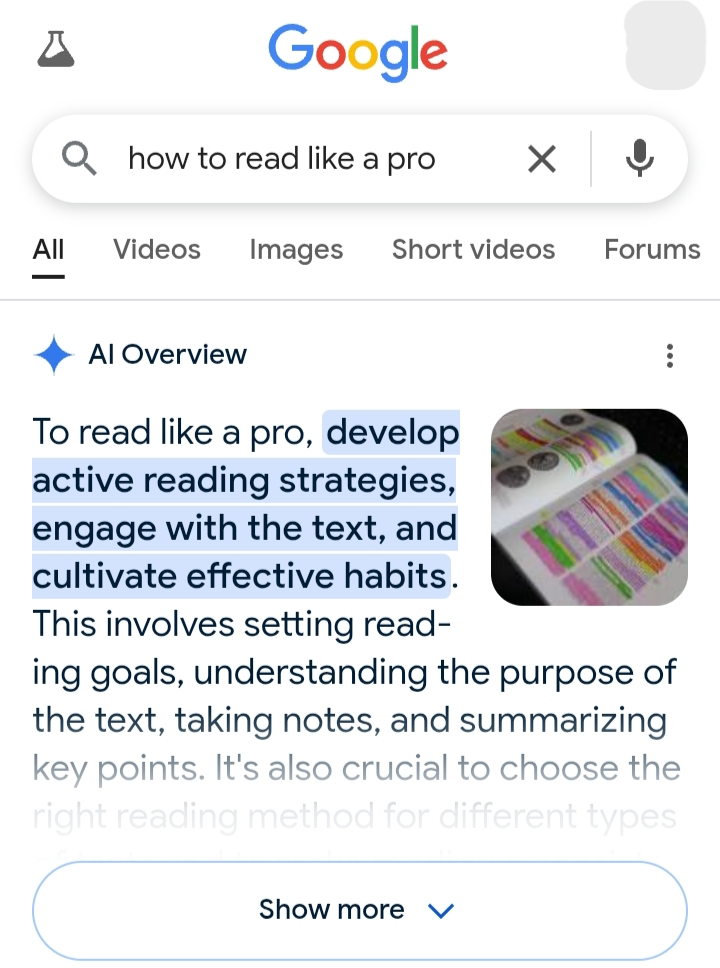
While this appears to be the norm, AI Overviews can also appear much later on the SERPs, like so:
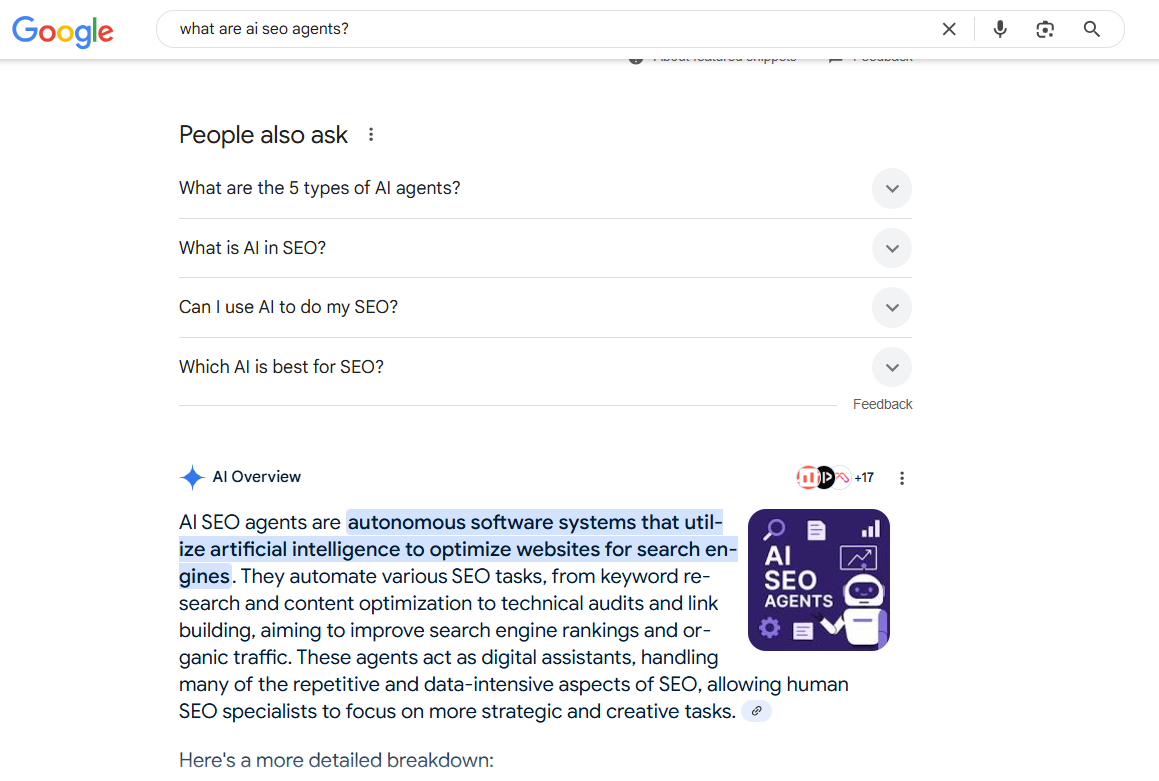
Here’s what you’ll often find inside:
AI-Generated Summary
At the top is a multi-sentence paragraph answering your query directly.
The language is typically clear, neutral, and easy to understand, designed to mimic a human expert’s summary.
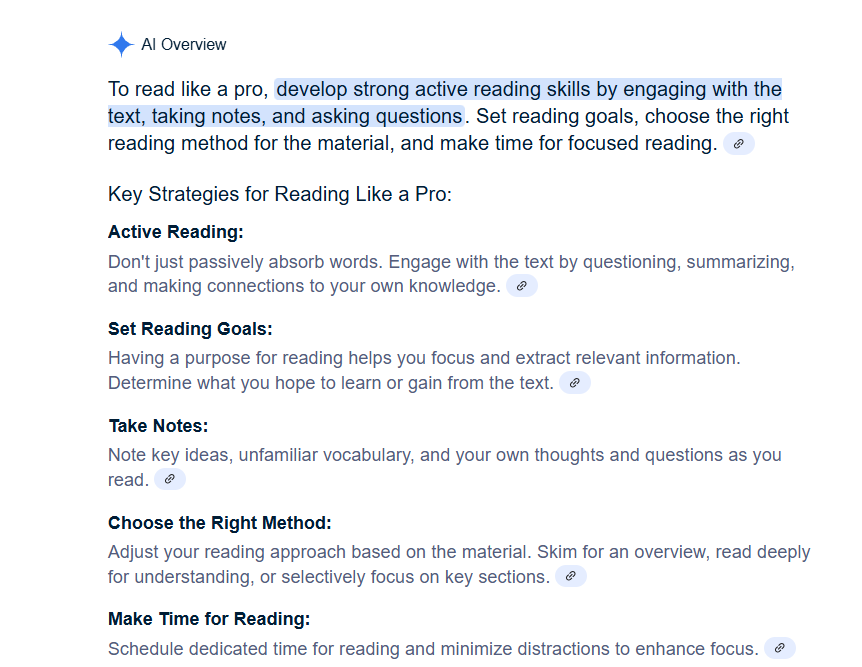
Source Links and Cards
Each sentence or fact in the summary is linked to a source used by the AI.
These links give users the option to verify the information and give credit to the original publishers.
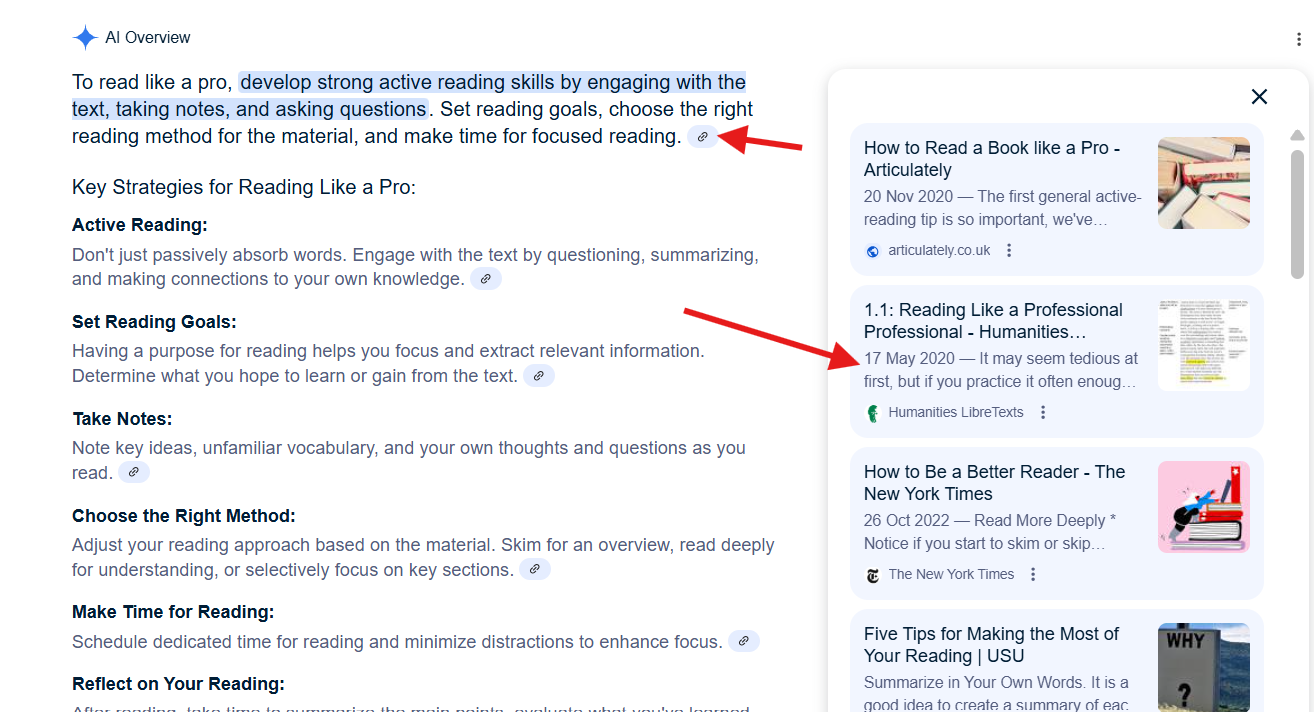
Visual Elements
For certain queries, like recipes, workouts, product comparisons, or DIYs, you may also see:
- Step-by-step breakdowns
- Images or icons
- Product cards or pricing information
When Does Google Decide to Show an AI Overview?
These AI responses are triggered by specific types of queries, mainly those that require clear, concise, informational answers or those that can benefit from summarized explanations.
They tend to show up most often for:
Informational / How-To Queries
These types of queries look for guidance on how to complete a task or process, and that’s where AI Overviews really shine.
Recent studies show that 88% of AI-generated responses in Google target informational intent, while only 8.69% focus on commercial queries.
Google recognizes that users want step-by-step help and responds with structured AI Overviews that include instructions, tips, and sometimes visuals.
Some examples of such informational searches are:
-
What is ice cream made of?
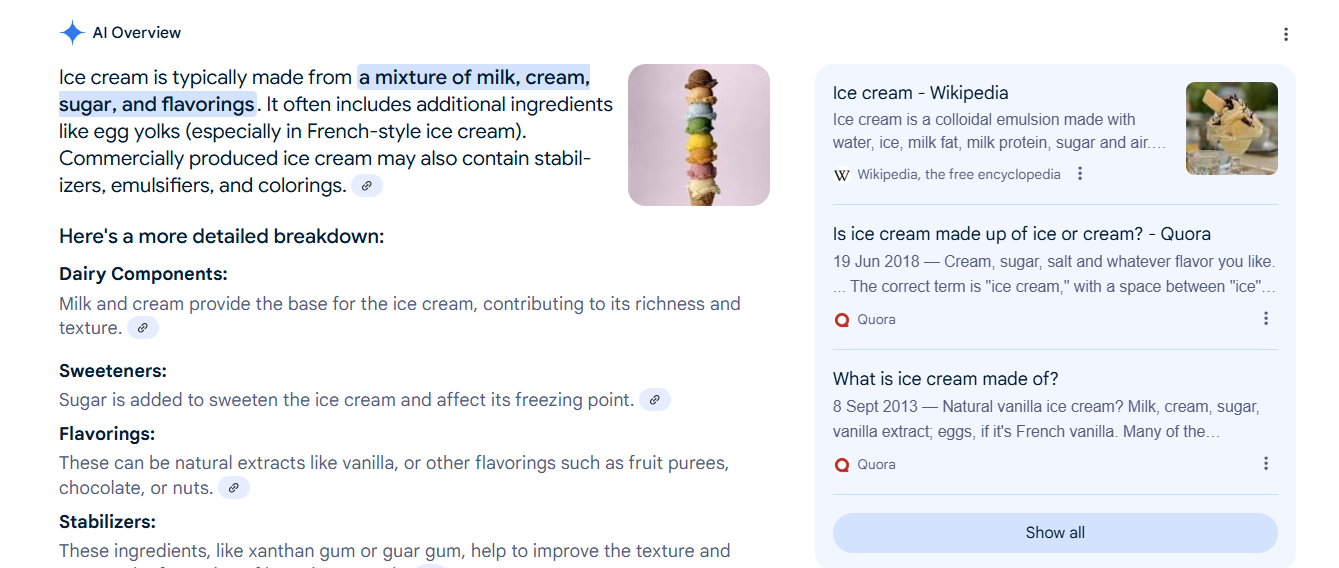
-
How to clean a laptop screen: Overview includes materials needed and do’s and don’ts.
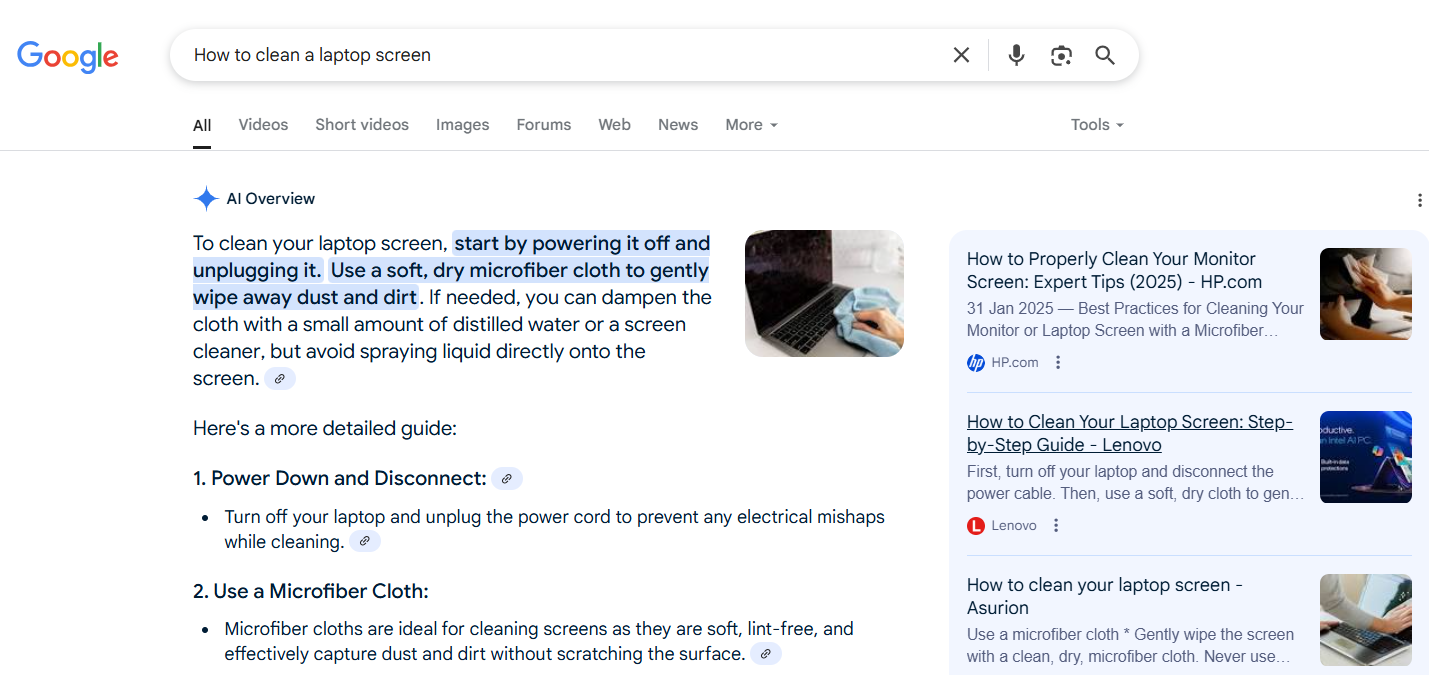
-
How do I update my Android phone?: Displays step-by-step instructions for different versions.
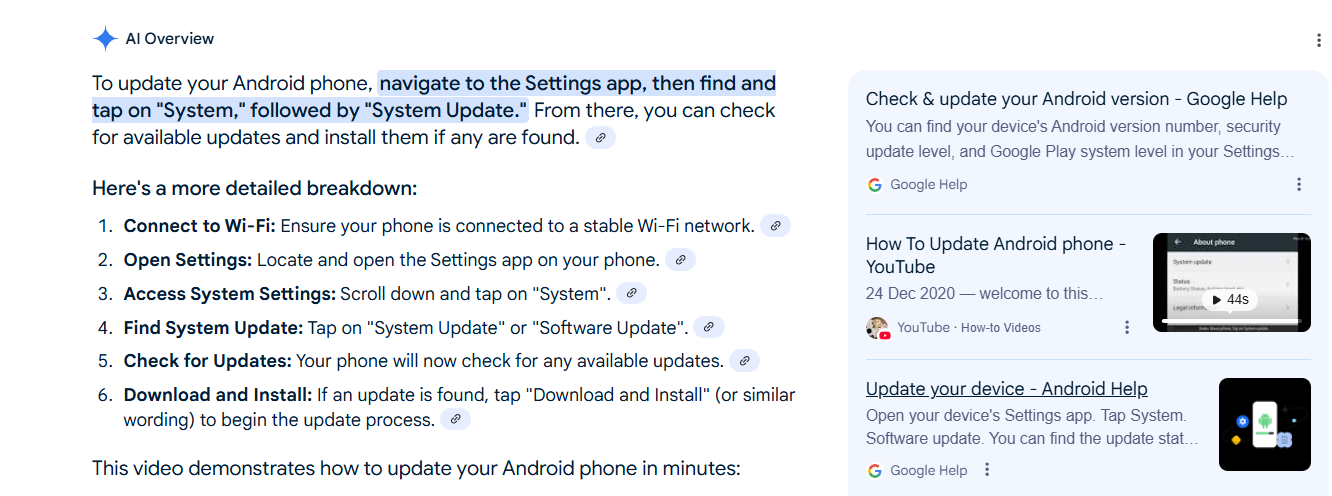
Comparative Queries
These queries ask Google to compare two or more items, ideas, or methods. AI Overviews respond by stitching together side-by-side comparisons, listing key differences, benefits, drawbacks, or suitability based on user intent.
For instance, if you search for:
- iPhone vs Samsung for photography
- Laptop vs tablet for students
- Keto vs paleo diet
Google AI will generate:
-
Feature-by-feature comparisons
-
Pros and cons
-
Best use cases or recommendations
-
Visual cards for specs, pricing, etc.
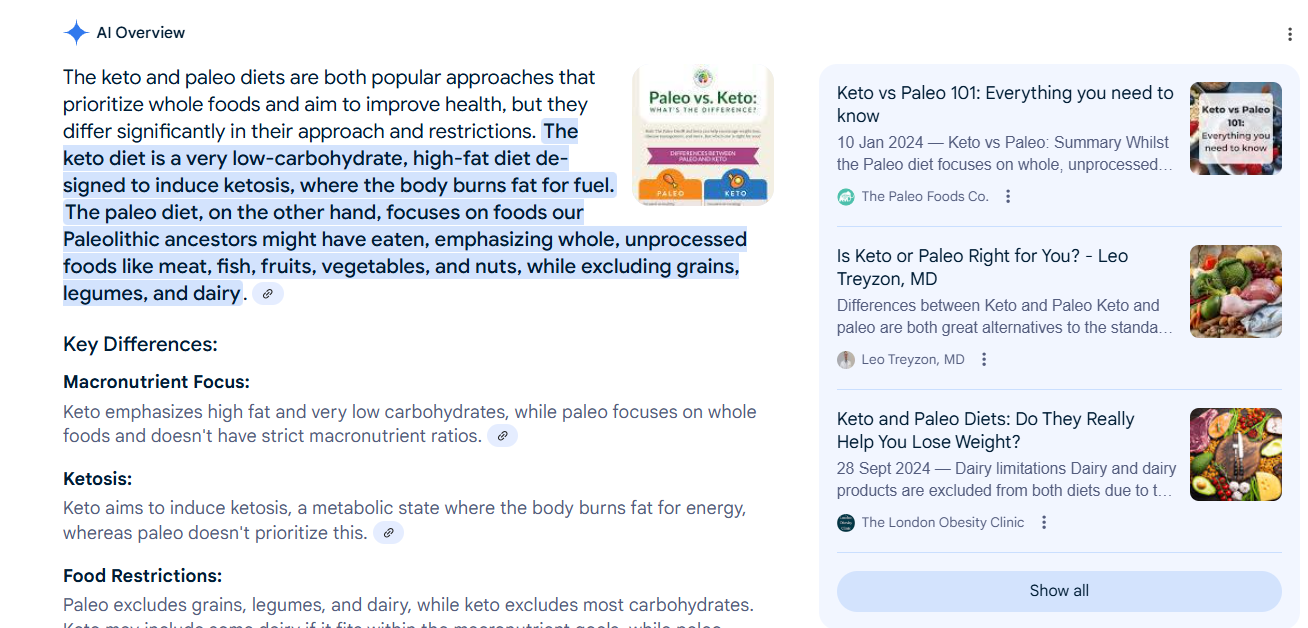
Decision-Making Queries
These queries often include “should I,” “which is better,” or “is it worth it” phrasing.
The AI recognizes these as high-intent decision points and returns practical recommendations.
If you search for “Should I lease or buy a house?”, expect a pros/cons list helping you make a decision based on cost, flexibility, and your lifestyle preferences.
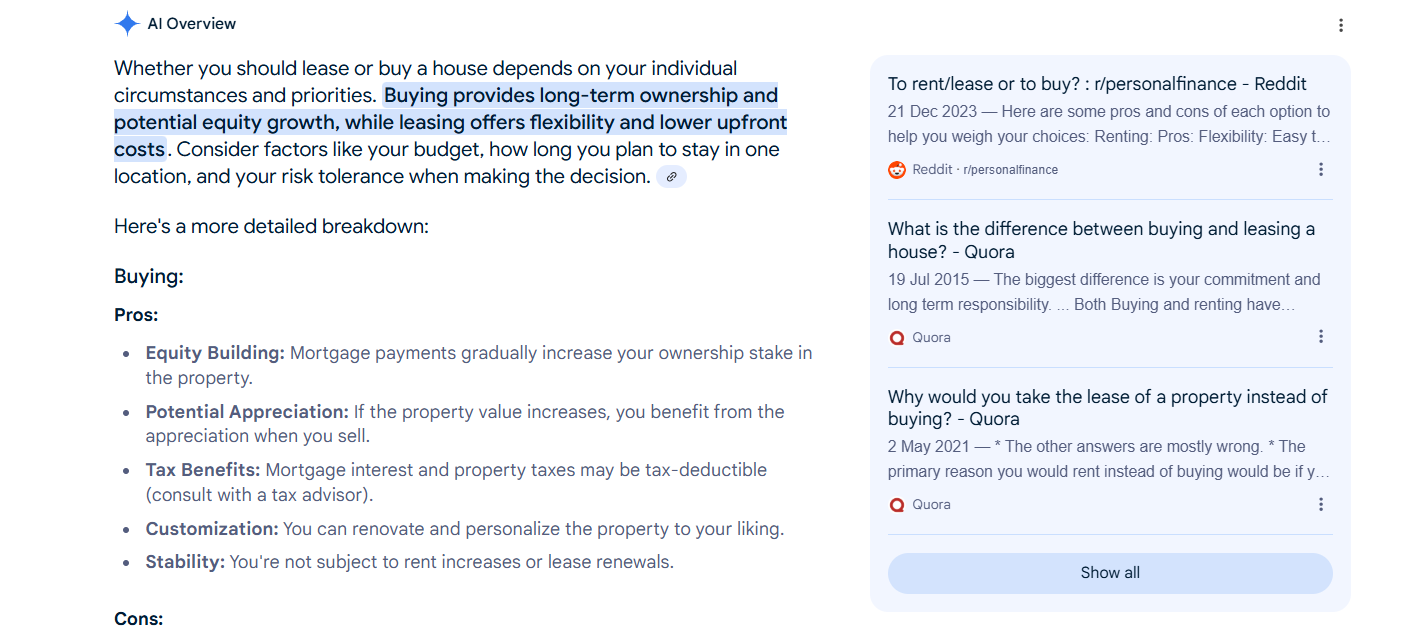
What Makes AI Overviews Different from Featured Snippets and Traditional Search?
To understand how AI Overviews is changing the game, it helps to compare them with what came before: Featured Snippets and traditional search results.
This section breaks down what makes AI Overviews a whole new kind of search experience.
AI Overviews vs. Featured Snippets
At first glance, AI Overviews and Featured Snippets might seem like they serve the same purpose: giving users quick answers at the top of Google’s results.
But they’re fundamentally different in how they work and what they mean for SEO.
Featured Snippets are extractive. They pull a direct quote from a single webpage, usually a paragraph, list, or table, and present it with a link to the source.
It’s Google saying, “Here’s what this site says, and we think it’s the best answer.”
Here’s a good example from the search term “how to boil tea.”
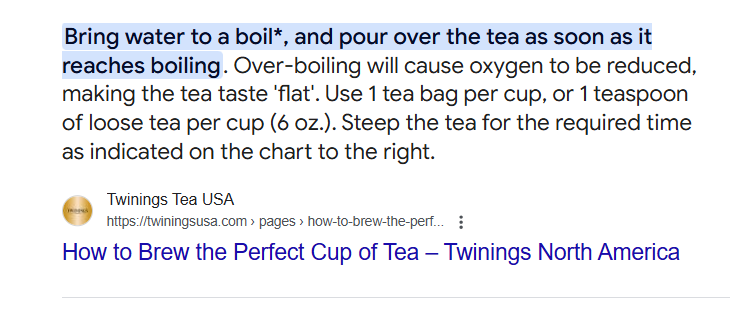
AI Overviews, on the other hand, are generative. Instead of quoting a single page, Google’s AI scans multiple trusted sources, interprets the information, and creates an original summary.
You’ll often see a longer block of text with suggested sources listed below, but not directly quoted. It’s more like Google saying, “Here’s what you should know, based on everything we’ve read.”
So, while the Featured Snippet for the query “how to boil tea” simply nudges you in the direction of an organic result, AI Overviews generate a completely original answer to your query based on all the available data on the internet.
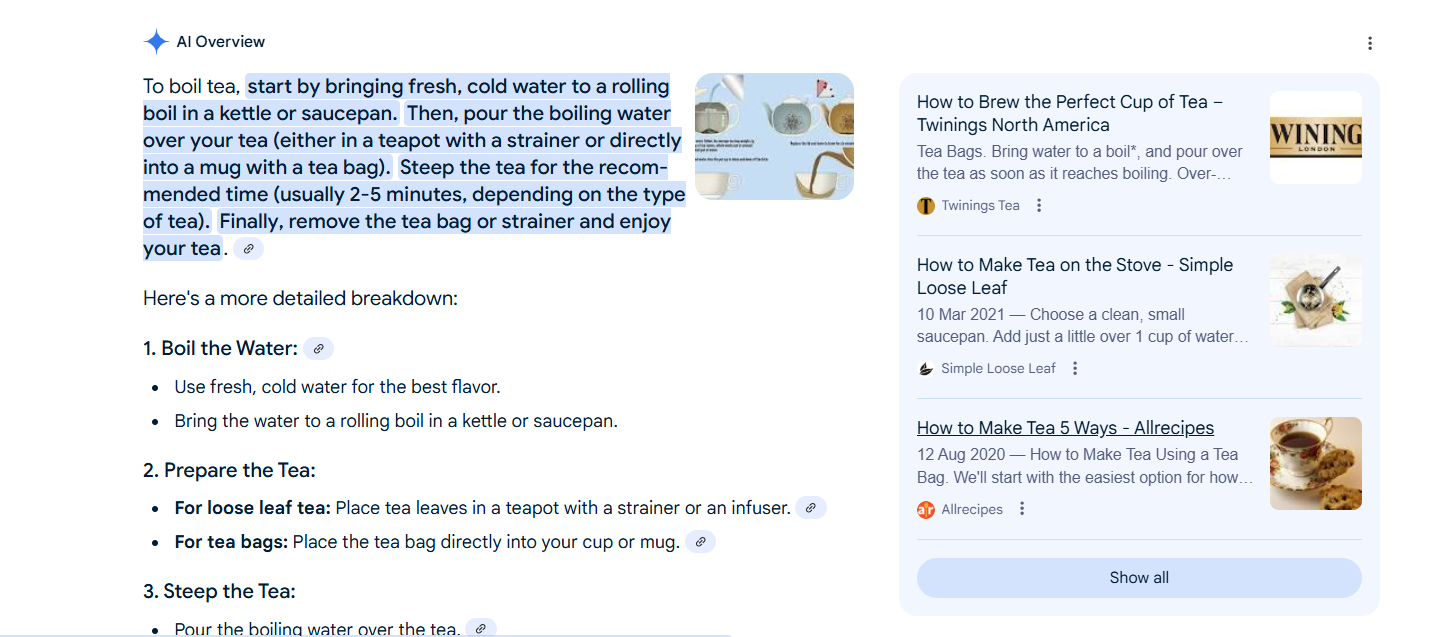
In short, featured Snippets quote you, while AI Overviews summarize you.
How Is AI Overviews Different from Traditional Search?
With traditional Search, you type in a query, and Google gives you a ranked collection of websites it thinks best answer your question.
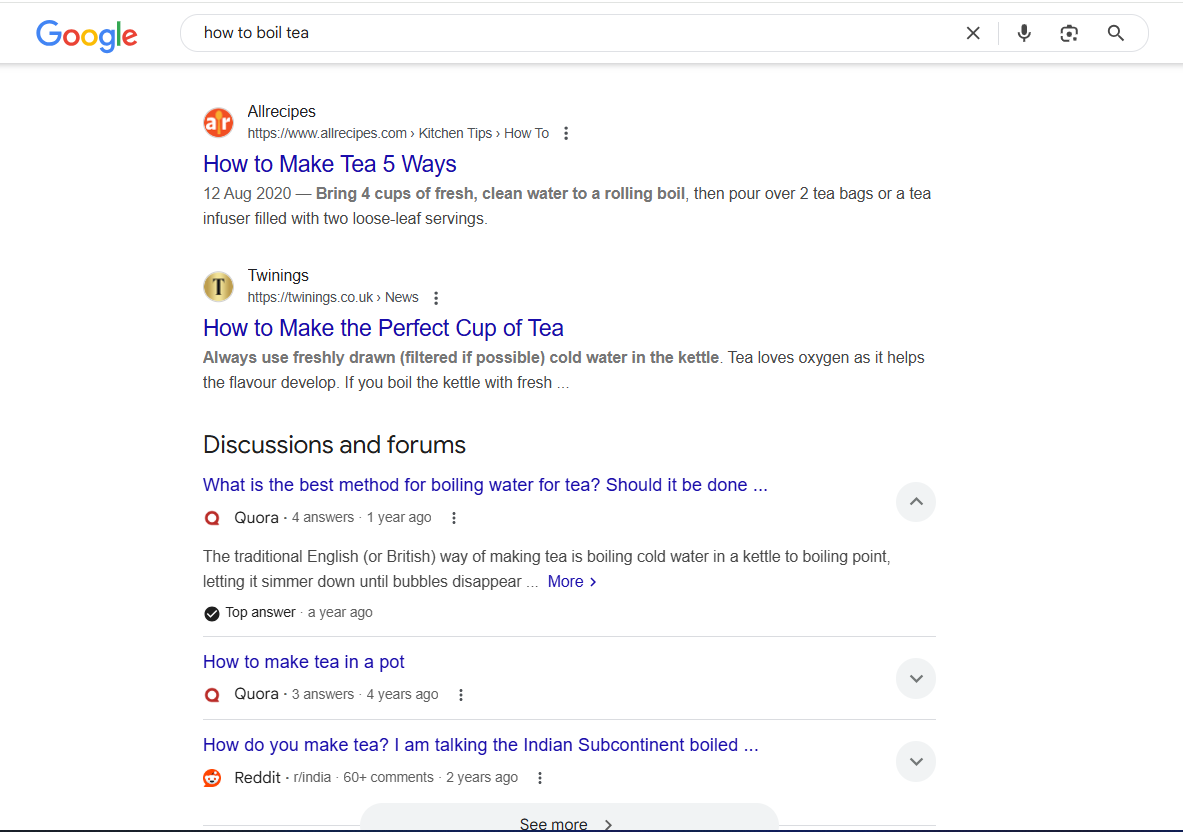
You then have to click through, scan each page, and piece together the information yourself.
AI Overviews flip that model on its head.
Instead of just pointing you to sources, it synthesizes answers for you.
Using generative AI, Google scans multiple web pages, pulls out key points, and presents a short, structured overview right at the top of the search results.
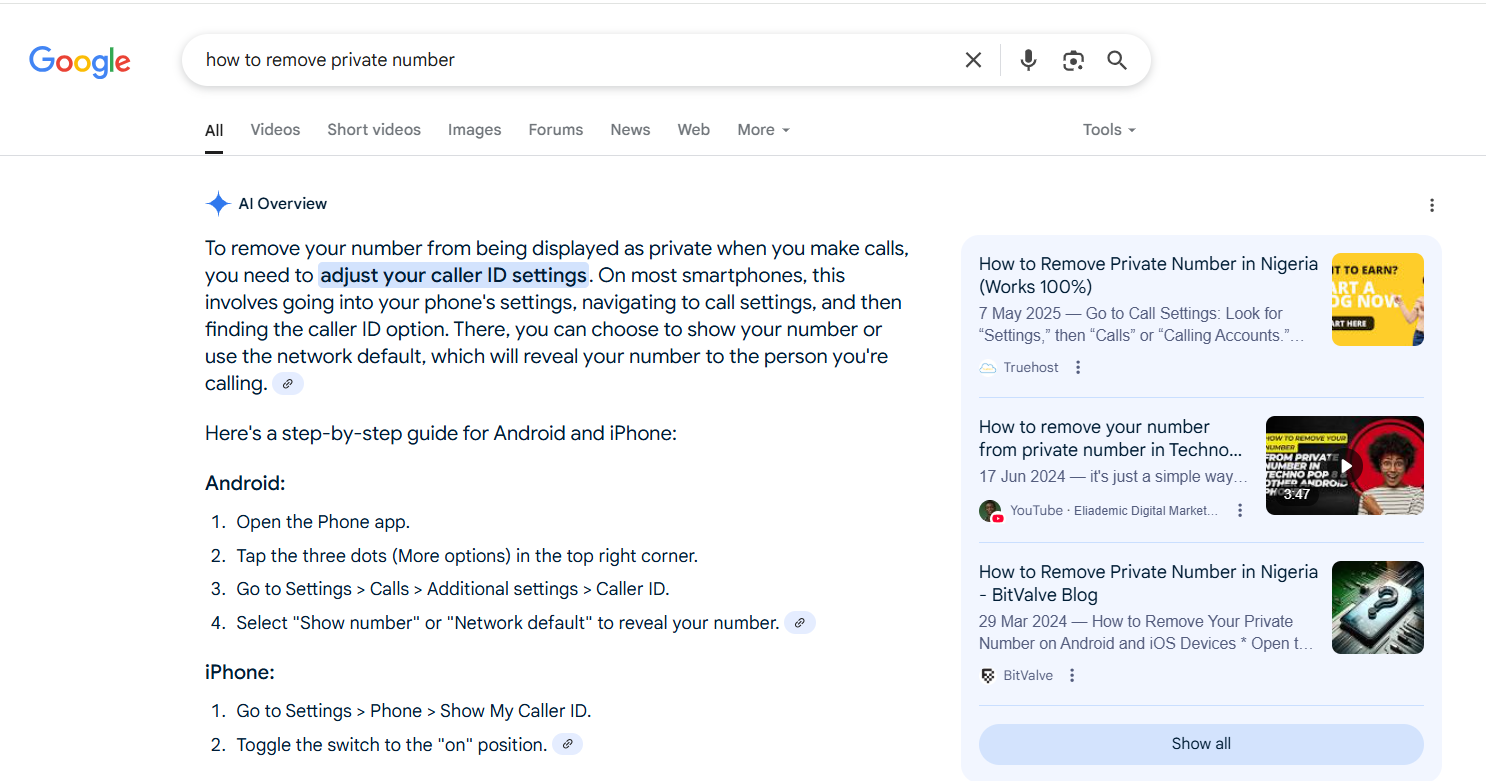
This preview often includes cited sources and a conversational tone that’s designed to feel like a human summarizing the internet for you.
How AI Overviews Are Affecting Search Behavior
Since 1998, Google Search has been like a map.
You type in a question, and it gives you a list of destinations you can explore to find what you’re looking for.
But with the introduction of AI search, Google now functions as your personal tour guide, telling you exactly what you need to know.
Let’s break down exactly how.
Google Is Moving From “Find” to “Tell”
Instead of helping you find information, Google now tells you what you need to know.
You search for something like “Is vitamin C good for your skin?” and within seconds, you’re given a summarized response, with key takeaways, step-by-step instructions, and source links, right at the top of the results page.

This marks a major shift in how people interact with search, and what it means to be visible online.
It’s Fueling the Rise of the Zero-Click Search
The “zero-click” trend, where users search but don’t click on any result, has been growing for years.
But AI Overviews are accelerating it.
Why?
Because users no longer need to click.
They get their answers immediately, often with visuals, summaries, and action points included.
In 2024 alone, over 60% of all global searches ended with zero clicks, and that number is expected to grow beyond 65% in 2025.
This is especially true for quick queries like:
- “Calories in an avocado”
- “Side effects of melatonin”
These used to send traffic to sites like Mayo Clinic or Healthline. Now, users get what they need directly from the SERP and move on, without ever visiting a website.
Search Behavior Is Becoming More Passive
One of the subtler changes is how AI Overviews are reducing the effort required to engage with search results.
Instead of users choosing a source, evaluating the content, and forming their own judgment, they’re presented with a pre-digested, simplified answer, which feels easier, faster, and more authoritative.
But that also means:
- Users may become less discerning
- They may stop clicking through to learn more
- They might never see dissenting or nuanced perspectives
A user searching “Is coffee bad for you?” might see a quick overview saying,
“Moderate coffee consumption is safe for most adults.”
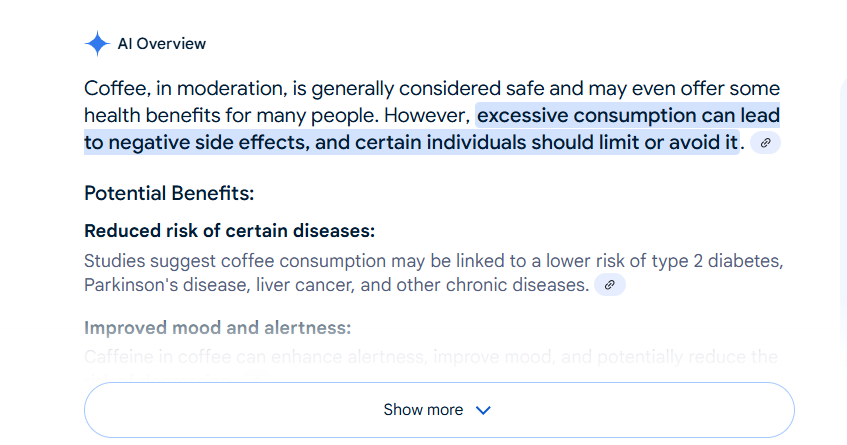
They may never read further to understand caffeine sensitivity, blood pressure issues, or sleep disruption.
This passive consumption model could change how people understand complex topics, for better (less confusion) or worse (less depth).
The Benefits of AI Overviews for SEO
AI Overviews are causing quite a stir in the SEO world, but it’s not all bad news.
While they do change the game, they also unlock exciting new opportunities for visibility, authority, and traffic, when approached strategically.
Here’s how:
Expanded Visibility Beyond Traditional Rankings
One of the biggest wins is that you don’t need to rank first to get noticed anymore.
With AI Overviews, Google pulls from multiple authoritative sources to build its summary. That means even if you’re ranking on the second or third page, your content can still be cited in the AI-generated answer shown at the top of the SERP.
For instance, ServiceNow’s blog post ranks seventh for the query “what is AI automation.”
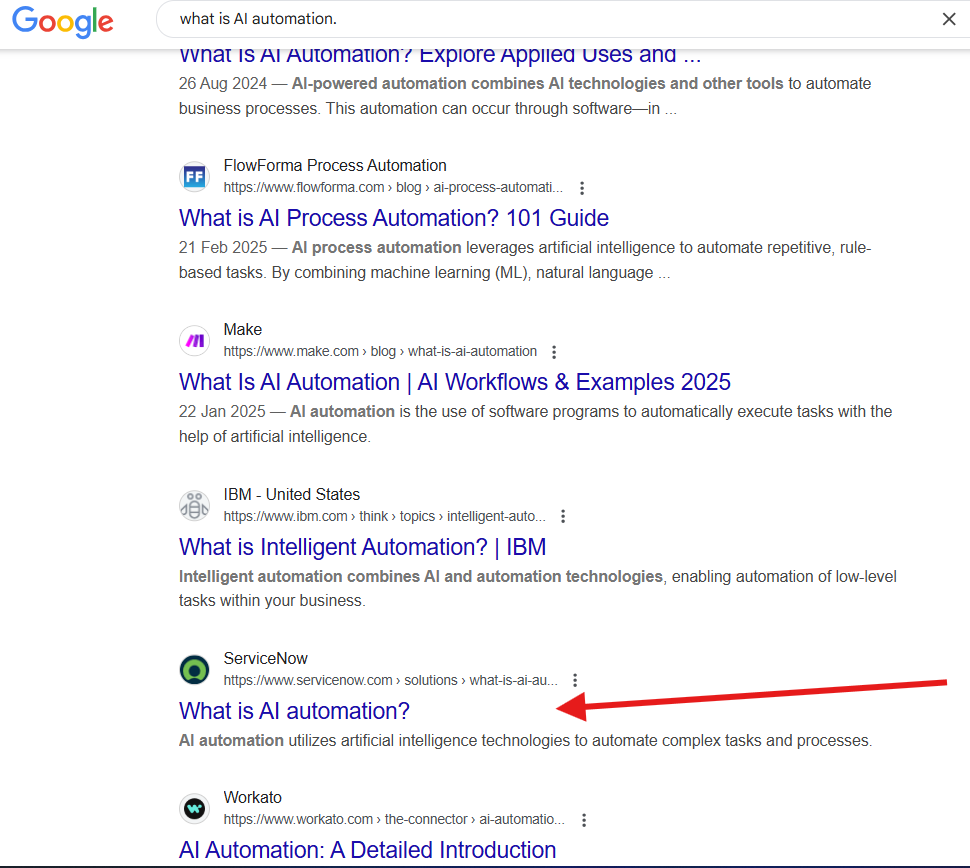
Ordinarily, that position wouldn’t drive much traffic. But thanks to a clear, well-structured explanation, the content is cited in the AI Overview, alongside top-ranking competitors.
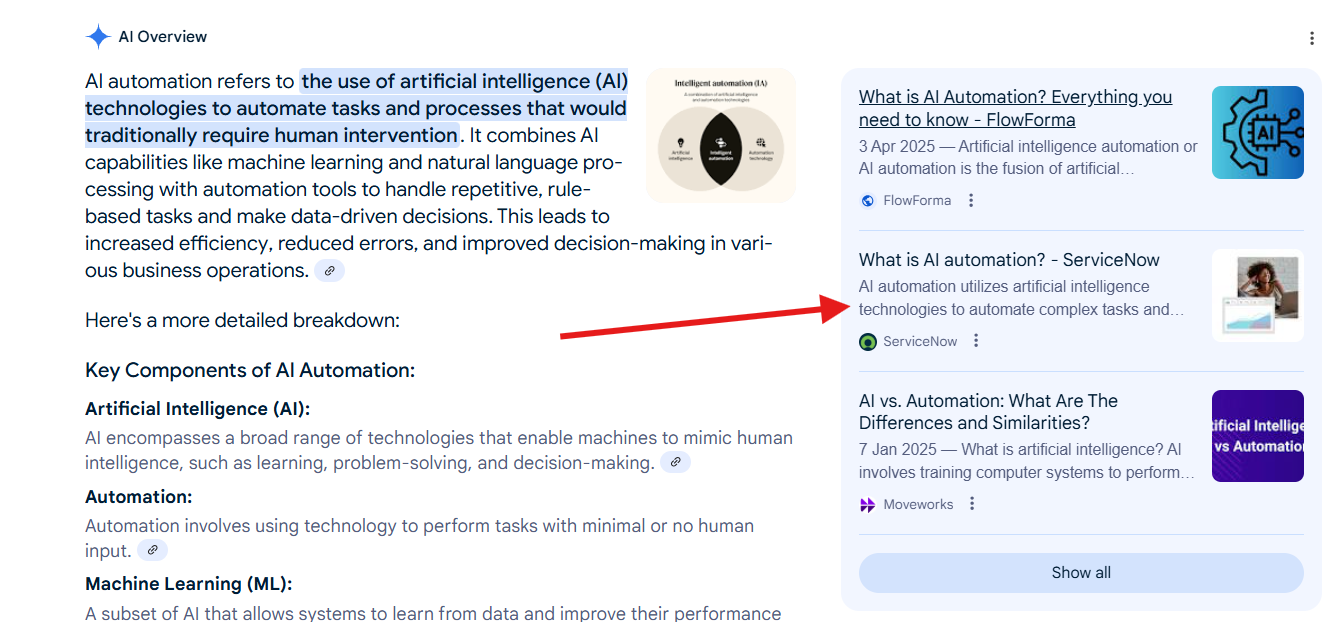
Opportunities to Build Trust and Brand Authority
When your site is included as a source in an AI Overview, it signals to users that Google considers your content reliable and relevant.
And even though users might not always click, seeing your brand name repeatedly across AI answers builds familiarity and authority.
If you’re consistently cited, users begin to recognize your name. So when they do need something more in-depth or transactional, they’re more likely to seek out or trust your brand.
Gives You Insight Into Content Google Trusts
Every time you see an AI Overview with citations, you’re looking at a blueprint for what Google values.
This allows you to reverse-engineer success:
- What kind of sources does Google pull from?
- How is the content structured? Does it have bullets? tables? short paragraphs?
- Are there common schema markups or formats being used?
For the search term “what are AI SEO agents,” a Nightwatch blog post appears in the AI Overview section.
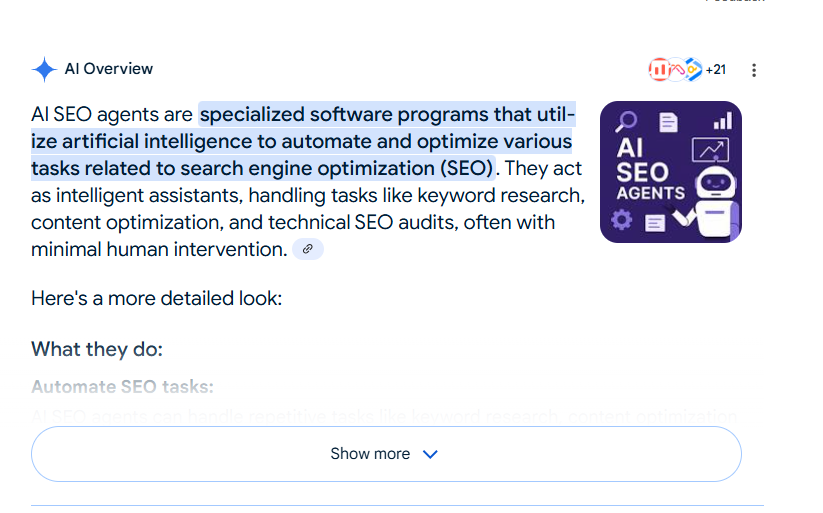
When you click through, you’ll notice that Google highlights a clear, concise definition of AI SEO agents within the article.
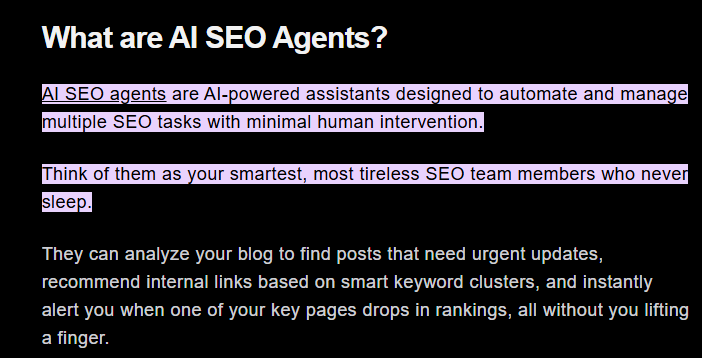
This suggests that Google favors content structured with question-based subheadings followed by direct, well-written answers, making it easier for the AI to extract relevant information.
By analyzing which pages consistently get cited, you can improve your own content to meet those quality and structure benchmarks and improve your odds of showing up, even if your domain isn’t massive.
Level Playing Field for Smaller Sites
In traditional SEO, domain authority plays a massive role in who ranks where.
Big brands often dominate Page 1 simply because of their trust signals.
But AI Overviews prioritize:
- Clarity
- Helpfulness
- Structure
- Topical relevance
That means smaller, well-optimized sites have a better chance of being selected, especially if their content is tightly aligned with specific user intents.
Challenges of AI Overviews for SEO
While AI Overviews open up exciting new opportunities, they also come with a fair share of uncertainty and risk.
Understanding these challenges is crucial for building strategies that adapt to this new environment.
Reduced Click-Through Rates
One of the most pressing concerns with AI Overviews is the decline in click-throughs.
Because the overview delivers a complete, summarized answer right at the top of the page, users often get what they need without visiting any website, even when your content is the source.
This trend hit a boiling point when Chegg, an educational platform, sued Google for using AI-generated answers that diverted traffic away from their site.
Sitting right at the top of the SERPs, AI Overviews are pushing everything else down and cutting the visibility of other features by as much as 140%.
And if your content targets informational queries? The hit is even harder. Some sites have seen their organic traffic drop anywhere from 18% to a staggering 64% since the rollout.
Take this scenario: a user searches “What is the keto diet?”
Google’s AI Overview pulls a definition and sample meal plan from your blog post. The user reads it, finds it helpful, and moves on, without clicking through.
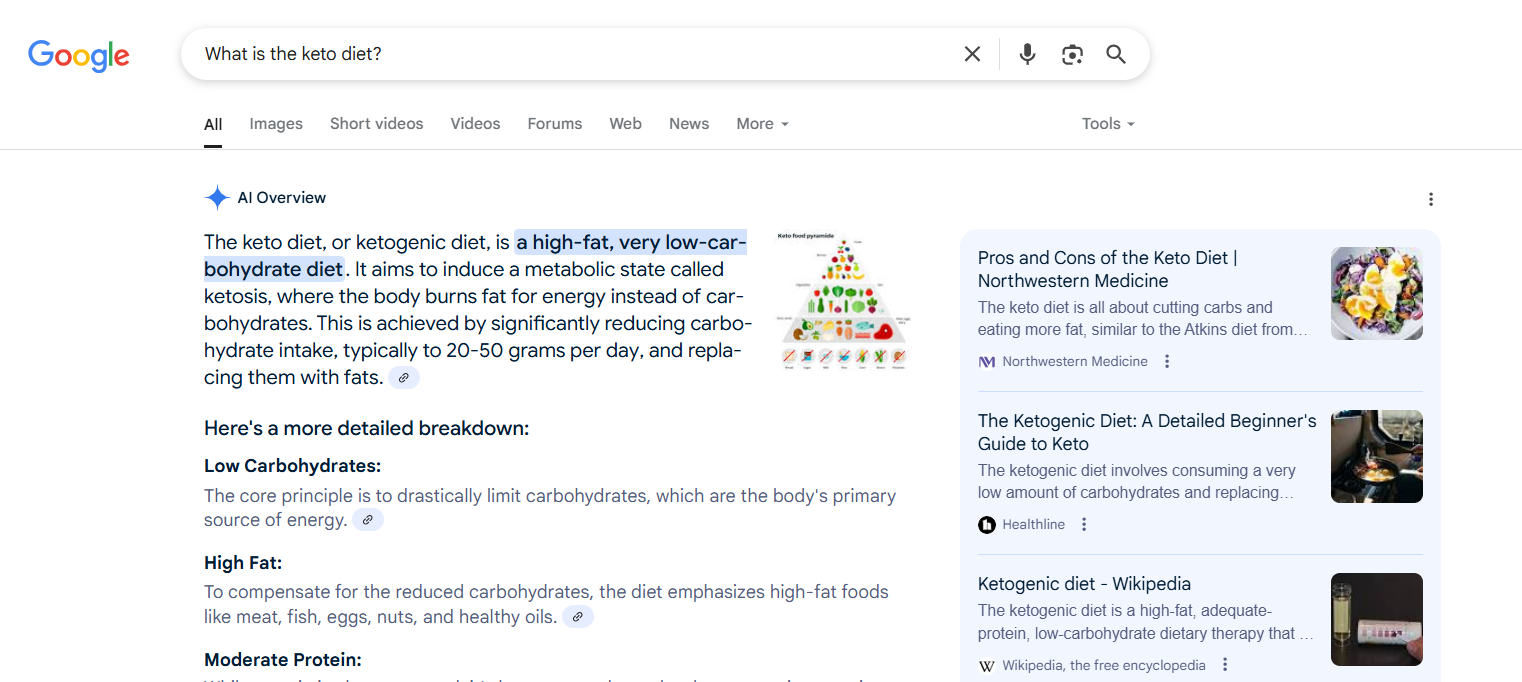
As a result, even high-quality, well-ranked content can see a sharp drop in organic traffic.
Lack of Clear Attribution and Credit
While Google does show source links in AI Overviews, the placement and visibility of those links can vary, and they’re not always obvious or consistent.
In some cases:
- Your content may be used without a clearly clickable link
- Citations may appear in a carousel or be hidden behind a “Show more” dropdown
- Users may not associate the information with your brand
This creates a dilemma: your content adds value to the AI’s answer, but you don’t always get the recognition or authority boost you deserve.
Increased Competition for Fewer Clicks
AI Overviews shrink the pool of organic traffic and intensify competition among publishers for the few remaining user clicks.
Where once there were 10 blue links on Page 1, now there’s:
- A giant AI answer
- “People Also Ask”
- Featured snippets
- “People Also Search For”
- Video results
- Ads
- Image packs
- And maybe then the traditional organic results
For example, when you search “how to grow long hair,” the results page includes an AI Overview, a featured snippet, a “People Also Ask” section, and other SERP data.
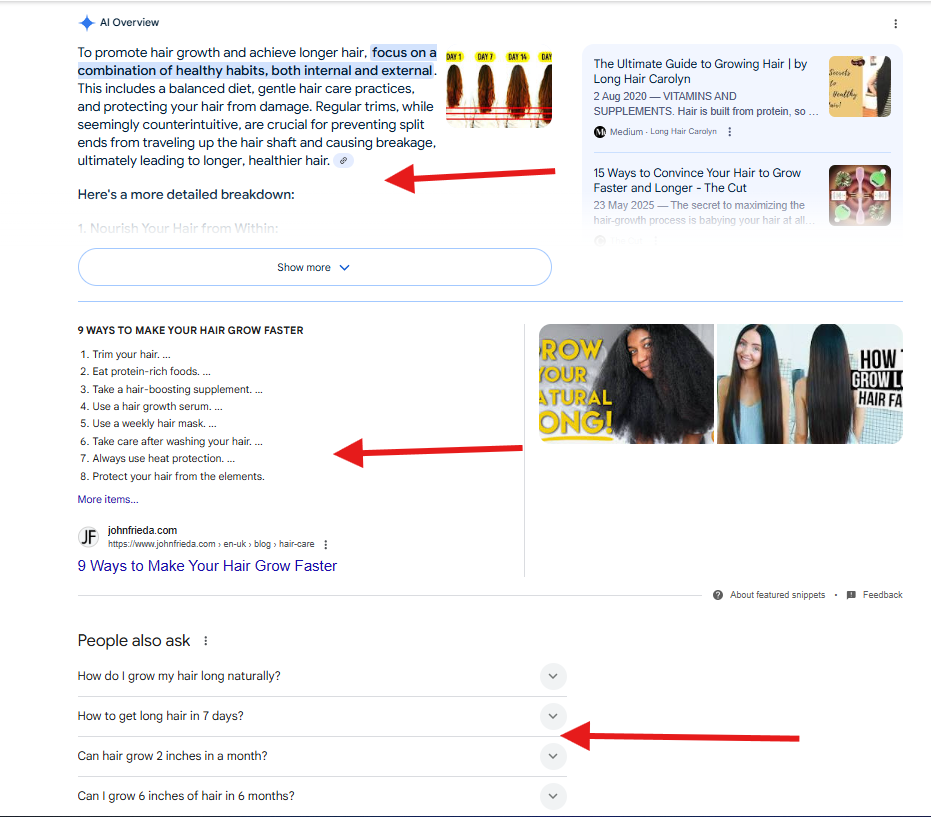
This means you’re competing not just with other websites, but with AI and Google’s own features.
Your content has to really stand out to earn that click.
And the worst part? Your click-through rates may drop even if your rankings stay the same.
Harder to Track ROI on Top-of-Funnel Content
AI Overviews reward informational content, but if fewer people click through, it becomes harder to:
- Track engagement
- Retarget visitors
- Drive newsletter signups
- Attribute conversions
This can discourage brands from investing in top-of-funnel SEO, even though it’s essential for long-term visibility and trust-building.
The result is a shrinking incentive to publish helpful, non-commercial content, which, ironically, is what AI needs to feed on.
How to Optimize Content for AI Overviews (Without Losing Your Mind)
Though ranking is more competitive now, the rules of the game haven’t entirely changed.
Google emphasizes that the same SEO tips that help you rank organically also apply to being featured in AI Overviews:
“The best practices for SEO remain relevant for AI features in Google Search (such as AI Overviews and AI Mode). There are no additional requirements to appear in AI Overviews or AI Mode, nor other special optimizations necessary.”
Their advice? Focus on creating helpful, people-first content that aligns with their creating reliable, people-first content guidelines.
If you need a refresher, let’s break those down into practical, creative, and actionable steps.
Cover the Entire Topic, Not Just the Keyword
If you’re still optimizing one keyword per page, it’s time to upgrade your strategy.
AI Overviews don’t pull content based on isolated keywords, but based on how thoroughly you cover a topic.
They curate answers from sources that anticipate user questions and offer well-rounded insights.
To make your content AI-ready, think beyond the headline keyword.
Use tools like Google’s People Also Ask, Reddit discussions, and Quora threads to find the real, layered questions users are asking.
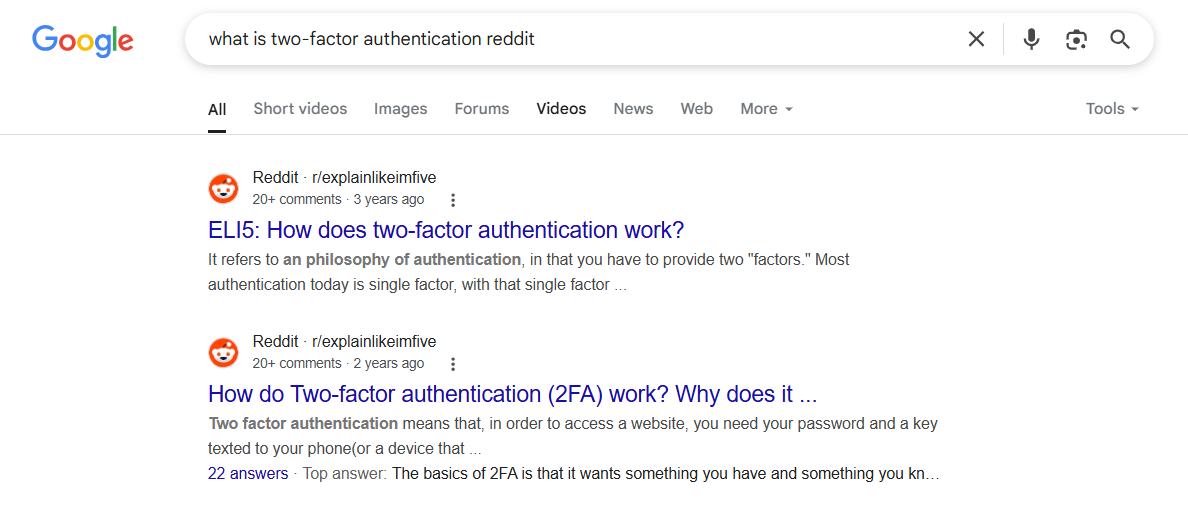
Then address those questions within the same page, not as separate blog posts or siloed content.
Let’s say you’re writing about two-factor authentication. Rather than writing a basic definition and calling it a day, structure your content to explore:
- What it is and how it works
- Why it’s critical for online security
- How it compares to multi-factor authentication
- Where and how it’s typically used (e.g., email, banking, social media)
- Step-by-step guides for enabling it on popular platforms (with screenshots or GIFs)
- FAQs and edge cases, like what to do if your second device is lost
The more angles you cover, the more likely your page is to be cited, even if you’re not in the top few organic results.
Use Clear, Consistent Structure
There’s no special trick to ranking in AI Overviews. You just need to make your content easy to scan for both people and search engines.
Here are some formatting tips that work:
-
Use H2s and H3s to organize your content logically: Break your content into clean, easy-to-navigate sections. Each should answer one core question or idea. Avoid stuffing multiple ideas under a vague heading.
Example: If you’re writing about “Email Marketing Metrics,” your H2s might be:
-
“What Are Email Marketing Metrics?”
-
“Why They Matter”
-
“7 Key Metrics to Track,” and more.
This helps both AI and users understand your content at a glance.
- Start sections with clear, concise definitions: When introducing a new term, define it in the first sentence. AI Overviews love snappy, unambiguous explanations.
- Use bullet points and numbered lists for clarity: Lists help break down information into digestible chunks, perfect for steps, pros and cons, features, or tips.
- Keep paragraphs short and punchy: Aim for 2–3 sentences per paragraph. Dense blocks of text slow readers (and AI) down.
- Apply FAQ and How-To schema: Use structured data to help search engines understand your content. Implementing FAQ schema or How-To schema boosts your chances of being featured in AI Overviews, rich results, or People Also Ask boxes.
A clear, well-structured page helps AI quickly identify the most helpful snippets, making you more likely to be featured, even if you’re not ranking number one.
Answer Questions Directly and Quickly
AI Overviews are built to deliver instant clarity.
If your answers are buried under long intros or fluff, you’re making it harder for the AI to select your content.
Instead, structure your writing like a smart, skimmable Q&A.
Use headers that match real search queries, such as:
- “What is X?”
- “How does X work?”
- “Why is X important?”
- “Pros and cons of X”
Then, answer directly in the first 1–3 sentences below each heading.
After that, expand with:
- Real-life examples
- Supporting data or stats
- Internal links to related content
- Visuals like screenshots, tables, or diagrams
Here’s a quick example:
Q: What is keyword cannibalization?
A: Keyword cannibalization occurs when multiple pages on the same website target the same keyword, making it harder for Google to determine which one to rank, often leading to both pages underperforming.
Follow that with subsections like:
- “How to Identify Keyword Cannibalization”
- “How to Fix It”
- A link to your in-depth SEO audit guide
The goal here is to become the cleanest, clearest source AI can extract from.
Because when it comes to Overviews, clarity wins.
Demonstrate EEAT (Expertise, Experience, Authoritativeness, Trust)
AI is cautious, especially when it comes to sensitive, technical, or Your Money or Your Life (YMYL) topics like health, finance, and legal advice.
To avoid misinformation, it leans heavily on sources that signal trust, authority, and relevance.
If you want your content to be seen as trustworthy by AI (and readers), take these extra steps:
- Add a detailed author bio. If you’re writing on specialized topics, mention degrees, certifications, years of experience, or relevant job titles. This is especially important for health and finance content.
- Cite reputable sources. Use data from peer-reviewed studies, .gov and .edu sites, or respected industry publications, not random blogs or forums.
- Include first-hand experience or original insight. Google values unique perspectives, especially when paired with expertise. Real examples, original research, or client results can give your content an edge.
The more your content looks, sounds, and reads like something an expert would say, the more likely AI is to pull from it, and the more readers will trust it, too.
Use a Conversational Yet Informed Tone
Google’s AI is trained on how people naturally communicate. It favors content that sounds helpful, human, and conversational, not like a technical manual.
So, if your blog still reads like a whitepaper from 2009, it’s time for a rewrite.
Here’s what makes content more engaging and AI-friendly:
- Use natural language. Write the way you’d explain a concept to a smart but curious friend. Keep the tone professional, but avoid rigid or overly formal language.
- Avoid robotic phrasing. Don’t cram in keywords at the expense of readability. AI knows when you’re writing for algorithms instead of humans.
- Bring ideas to life with relatable examples, analogies, or real-life scenarios. This helps users (and AI) understand and retain complex ideas more easily.
Let’s compare two definitions of two-factor authentication:
A: “Two-factor authentication is a security measure that augments the login process by incorporating multifactor credentials.”
B: “Two-factor authentication adds extra security by requiring a password and a code sent to your phone. Even if someone steals your password, they can’t log in without that second layer.”
AI will favor B, not because it’s “dumbing things down,” but because it’s clear, relatable, and easy to digest. It answers the question and makes the benefit obvious.
So, write to connect, not just to inform. The more your content mirrors how people naturally speak and explain, the more likely it is to be picked up by AI, and appreciated by readers.
Use Rank Tracking Tools to Measure Impact
Optimizing for AI Overviews is a continuous process of learning, testing, and refining.
Just like with traditional SEO, you need data to understand what’s working and where you’re slipping.
That’s where tools like Nightwatch become your secret weapon.
Nightwatch gives you the visibility and insight to:
- Track your organic rankings daily or weekly, including shifts caused by AI Overviews or other SERP features.
- Spot fluctuations in keyword visibility, whether your content is climbing, slipping, or being replaced by competitors.
- Monitor special placements, like featured snippets, People Also Ask, and AI Overviews, so you can see how Google is presenting your content.
- Compare performance across locations and devices to understand where you’re winning and where there’s room to grow.
Now, let’s see this in action:
Say your guide on “how to use Google Search operators” was showing up in the AI Overview for the query “best ways to refine Google searches.”
For a while, you were getting great impressions, even some branded recognition as a source.
But then, you notice a drop in clicks.
![]()
With Nightwatch, you quickly spot that your page has disappeared from the AI Overview box, even though your rankings for related keywords haven’t changed much.
That early alert gives you time to:
- Revisit the section that was previously cited
- Tighten up the language or formatting
- Add new examples or update screenshots
- Reconfirm your information is still accurate and relevant
Sometimes, a small tweak, like turning a dense paragraph into a bulleted list, is all it takes to regain that featured spot.
Frequently Asked Questions
What is the AI Overview on SERP?
AI Overview is a feature in Google Search that uses generative AI to summarize answers directly at the top of the search results page (SERP). Instead of just showing links, it provides a quick, conversational response pulled from multiple sources to answer the user’s query instantly.
Who writes the AI Overview?
AI Overviews are generated by Google’s AI models (like Gemini). No single human writes them. Instead, the AI scans and synthesizes content from various high-quality sources across the web, combining key insights into a single summary. Credited sources are often listed below the overview, but the summary itself is original AI-generated text.
How do you write content for AI Overviews?
Answer questions clearly using headings that match common search queries. Structure your content with bullet points or short paragraphs, use schema markup, cite credible sources, and write in a natural, human tone.
Is the AI Overview accurate?
Generally, AI Overviews aim to provide reliable summaries by pulling from trusted, authoritative sources. However, they are not perfect. Like any AI-generated content, they can sometimes misinterpret context, oversimplify complex topics, or even “hallucinate” incorrect facts. That’s why Google includes source links, so users can verify the information themselves.
AI Overviews Are Here. Now What?
AI Overviews aren’t going away. And while they offer exciting new opportunities, they also demand a new level of adaptability, resilience, and creativity from SEO professionals.
The key isn’t to panic but to evolve.
Instead of chasing outdated SEO playbooks, double down on what truly works: creating helpful, well-structured, and in-depth content that answers real questions with clarity.
And as the SERP evolves, so should your approach. Tools like Nightwatch make it easier to monitor your performance across devices, locations, and AI-enhanced features, so you’re never left guessing where you stand or what to do next.
Search is changing fast. Stay sharp, stay flexible, and build a strategy that’s ready for whatever comes next.
